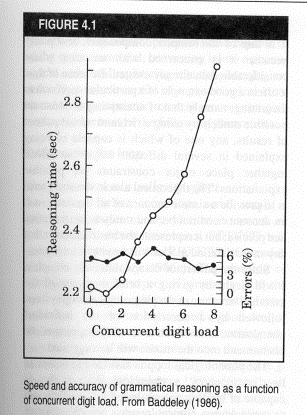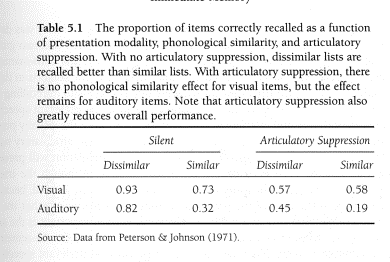
Psychology
342 Learning & Memory
Short-Term
(Working) Memory
I.
Short-Term Memory
A.
Capacity of primary memory
George Miller (1956)—“The magic number seven, plus or minus two"
Two main findings:
(1) Ss are unable to identify a
set of items that vary along only one dimension if there are more than a few
items

(2)
Chunking
Increase capacity of short-term memory by grouping individual units of information into meaningful units.
II.
Duration of the Trace in Short-Term Memory
Brown-Peterson Paradigm
A.
Purpose—determine rate at which information decays in STS
B.
Method—experimenter reads a consonant trigram and then 3-digit number. S had to count backward by 3 from the 3-digit number for a
certain amount of time then had to recall the trigram.

C.
Results-- rapid rate of forgetting after as little as 18 s
Forgetting
in short-term memory--decay or interference?
What is proactive interference (PI)?

III.
Atkinson & Shiffrin (1968)
Distinguished between structural
and processing components of memory.
The structure is thought to be
those parts of the memory system that do not change

Three structures:
(1) sensory registers, (2) STS, (3) LTS
Information transfer from STS to LTS under Ss control (control processes)
Transfer
begins and continues during the entire time an item is in STS because learning
takes place even when the S is not trying to remember the material.
Repetition
of an item (even if unaware) leads to better performance
Two
main control processes in STS—retrieval and rehearsal.
Because
of decay, retrieval process must be both very fast and highly efficient
Atkinson
and Shiffrin suggested the concept of a human memory system that keeps track of
incoming information and exercises some control over its information-processing
capacity
IV.
Immediate or Working Memory
A.
Definition
Attkinson
& Shiffrin’s model describes STS as a working memory
A
system that temporarily holds and manipulates information as part of a wide
range of cognitive tasks (i.e., learning, reasoning, comprehending).
Does
STS really serve as a general, unitary working memory where storage and
manipulation compete for space in a limited capacity STS?
B.
Evidence
Use
dual-task technique--S is required to perform one task that absorbs most of the
capacity of his/her working memory, while at the same time performing learning,
reasoning and comprehension tasks.
Assumption:
Performing a concurrent STM task should lead to a dramatic impairment in
performance.
Baddeley (1986)--Ss were required to remember number sequences ranging from zero
to eight digits in length, while at the same time performing a reasoning test.
Effect of concurrent memory load on the speed and accuracy with which Ss
performed the syntactic reasoning test:

Results:
(1) reasoning time increases clearly and systematically with concurrent memory
load (2) The effect, however, is not catastrophic
If
STS is a unitary system, a concurrent load of eight digits should cause
reasoning performance to break down completely. It does not.
Earlier
concept of a unitary STS is challenged and replaced by a multi-component working
memory model.
V.
Working Memory model (Baddeley, 1986)
A.
Revised definition of STS
The
limits of digit span may be set by one of a number of subsystems, leaving other
components of working memory relatively unimpaired.
Baddeley proposed a model of working memory in which a controlling attentional
system supervises and coordinates a number of subsidiary slave systems.
Three
components—(1) central executive, (2) articulatory or phonological loop, and
(3) visuo-spatial sketchpad
.
B. The Phonological Loop
Phonological loop activity
1. What kind of substitution errors did you make?
2. Did you substitute an item that was acoustically similar to the correct item?
3. If you recorded a number in place of a letter, was it a letter acoustically similar to the number?
4. Did you confuse an M with N?
5. Were you fairly accurate in recalling W on the 2nd trial? Why might that be?
Purpose: account
for evidence regarding importance of speech coding in STM
Phonological
loop = phonological store +
articulatory control process
Helps to explain
the following phenomena:
(1)
Phonological similarity effect-- memory is worse for items that sound alike than
for items that differ.
PGTCD
is harder to recall from memory than the sequence RHXKW
Assumed
to occur because the store is based on a phonological code, so similar items
will have similar codes. Recall
will require discriminating among the memory traces.
Similar traces will be harder to discriminate, leading to a lower level
of recall.
(2) Articulatory suppression--Ss
say a word, such as “the,” over and over out loud.
Assumption: Repeating “the” occupies the
articulatory control process. Should be no covert rehearsal using the
articulatory control process. Without covert rehearsal, visual information cannot be
translated into a phonological code and so cannot be placed into the
phonological store. Should be no phonological similarity effect.
Should
still be a phonological similarity effect for auditory items.

Results
support predictions
(3) Unattended or irrelevant speech effect—unattended verbal material impairs
recall
Colle
and Welsh (1976) had two groups of Ss recall visually presented consonants, but
one group saw the consonants while some irrelevant speech was played in the
background.
Relative
to the Ss in the quiet condition, Ss who heard irrelevant speech were not as
successful in recalling the information.
Assumption:
phonemes from the irrelevant speech enter into the phonological store and
interfere with the information about the visually presented items.
**The
unattended material (nonsense syllables disrupt performance to the same extent
as words) was gaining access to the phonological store, a store that holds
phonological but not semantic information.
What
about unattended music? (Salame & Baddeley, 1989)
(4)
Word-length effect--short words (man, dog) are recalled better than long
words (gentleman, canine).
Baddeley,
Thomson, and Buchanan (1975)--word length and pronunciation time.
As
the number of syllables in the words increased, the proportion of words that
could be recalled decreased.

Results--linear relationship
between how long it takes to pronounce a word and the level of recall.
Working Memory explanation--number of items that can be immediately recalled
depends on how often each item can be subvocally rehearsed by the articulatory
control process
The
shorter the items, the more items can be rehearsed before a particular trace
decays.
Immediate memory is where
“cognitive work” is performed
